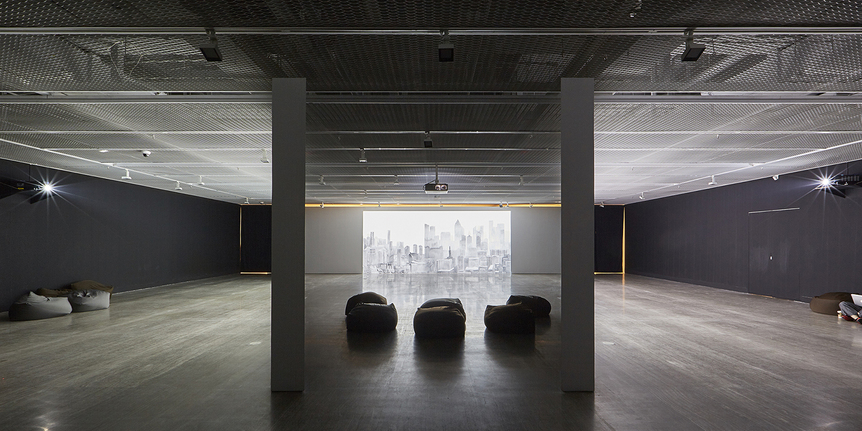-
From Current Issue
-
- Editor’s Letter Fire in the Heart
- Reviews I Gusti Ayu Kadek Murniasih
- Reviews 11th Seoul Mediacity Biennale: “One Escape at a Time”
- Dispatch Networked China
- One on One Monira Al Qadiri on Yukio Mishima
- Essays The rise of independent art spaces in pandemic-era Shanghai
- Features Tuan Andrew Nguyen
- Table of Contents
- Web Exclusives
- Archive
- Subscribe

R
E
V N
E
X
T
It was dead silent when walking through the thicket of curtains on the third-floor gallery of Fosun Foundation—an unexpected turn in what was promised to be an immersive audio-visual experience of Qiu Anxiong’s latest labor of love: the final film of his “New Classic of Mountains and Seas” trilogy. The ambitious series, which Qiu had produced over the span of a decade by weaving together hundreds of paintings that resemble the ink-like touch of Chinese calligraphy or traditional landscape paintings, was three animations that took Shanhai Jing (The Classic of Mountains and Seas)—an ancient Chinese cosmography that can be traced back to the fourth century BCE—and its mythical creatures as the films’ visual inspiration to construe imagined dystopias of the far future, where human life finds its footing in a post-apocalyptic world. At Fosun Foundation’s presentation space, visitors could finally indulge in a first-ever marathon of the three films.
But where was the sound and music? Halfway through experiencing the lyrical films, an attendant indicated that the accompanying score could be accessed through the gallery’s WeChat app—China’s multi-functioning text messaging application. What ensued was an all-encompassing encounter that belied the calm atmosphere of the gallery.
Projected across the wide drywall erected across the room, New Classic of Mountains and Seas I (2006) was accompanied by eerie music that fits the film’s vast empty world overrun with half-animal, machine-like hybrid creatures. A mushroom cloud suggests that a nuclear blast brought civilization to its end and silence upon earth’s crust. Seconds later, the war-torn soil births figures from ashes. These creatures resemble weapons of war, and run amok while elements of nature, such as vines, tear apart manmade structures—the diseased remnants of civilization.
The second entry of the trilogy, which was made in 2007, was screening on a separate wall at the opposite side of the room. Again, the tales of humanity’s future are menacing, this time on a microscopic, cellular level. The film depicts jars with self-generating body parts and mutilated mice growing in petri dishes, hellishly multiplying. Here, we see what humanity has achieved in biotechnology rendered as a grotesque, synthetic and systemic world.
Premised on the overlapping of the virtual and real worlds in today’s information society, New Classic of Mountains and Seas III (2016) uses 3D renderings and CGI to bring its content alive. It is Qiu’s most vivid, painstakingly illustrated and technologically advanced film. The movie begins with what seems like a lone suicide against the backdrop of a terminated civilization: derelict skyscrapers overrun by nature still stand, while frail humans wear octopus-shaped masks indoors, running on treadmills driven by pelted hunting dogs. Surprisingly lucid, this new ecology lays the visual landscape for French cultural theorist and “philosopher of speed” Paul Virilio’s theory that rapid urbanization and modern technologies will see to the destruction of the social, environmental and political worlds. Watching the films, the visitors, still wearing their headphones, look around to see the disconnect between themselves and their neighbors.
In his satirical trilogy, Qiu’s worldview is unpacked completely: humans are parasitic beings enslaved by their cannibalistic goals to advance, and injure the existence of all life—including our own. For these films, Qiu makes explicit the forsaken state of contemporary societies’ environments, humanity’s dying traditions and the systemic abuse of nature. His engrossing fictional animations serve as rhetorical bait that tells uncomfortable truths: geopolitical conflicts cannot be disentangled from the wars that frequently destroy Earth’s landscape, and with it, entire communities. It is no secret that the environment occupies a passive place in political discourse, and human life and our bodies are increasingly subjected to and governed by the apparatuses of power that serve nation states and capital.
With a penchant for storytelling, the artist exposes these techniques of governance—or rather, its inevitable outcomes of a dystopic post-human world in its continuation—and confronts the viewer with his critical and visually stunning films. The artist speaks volumes in animated metaphors, putting into perspective that rather than self-serving societies, there may be beauty in its total destruction—beauty in nature reclaiming its existence.
Julee WJ Chung is ArtAsiaPacific’s assistant editor.
Qiu Anxiong’s “The Mirage of Mountains and Seas” is on view at Fosun Art Center, Shanghai, until October 7, 2017.
To read more of ArtAsiaPacific’s articles, visit our Digital Library.






